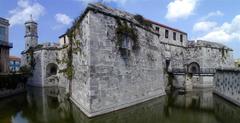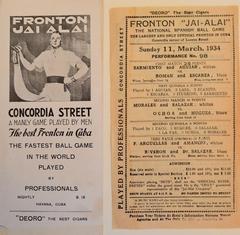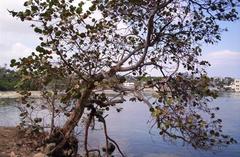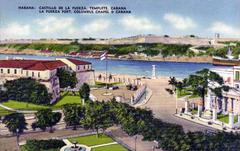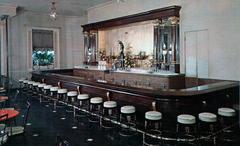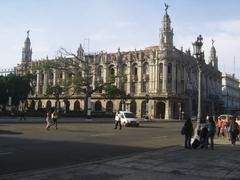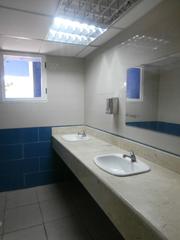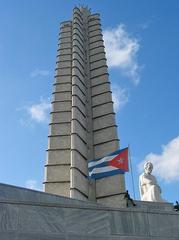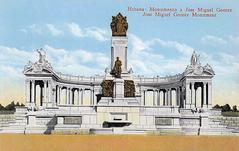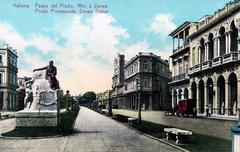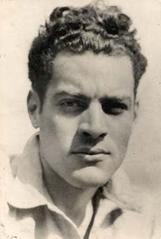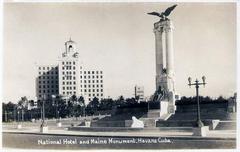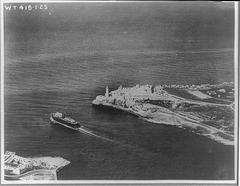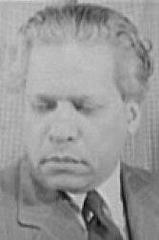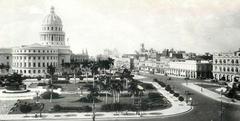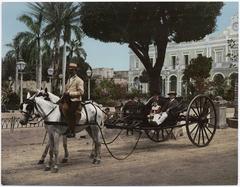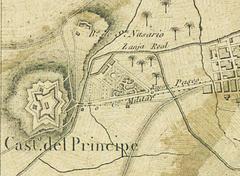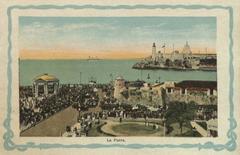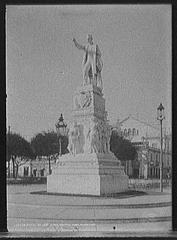Fundación Alejo Carpentier Visiting Hours, Tickets, and Havana Historical Sites Guide
Date: 14/06/2025
Introduction: The Significance of Fundación Alejo Carpentier
Located in the heart of Havana, the Fundación Alejo Carpentier stands as a tribute to Alejo Carpentier y Valmont (1904–1980), a pivotal figure in Latin American literature and culture. Born in Switzerland to a French architect and Russian mother, Carpentier’s upbringing in Havana fostered a unique multicultural perspective that deeply influenced his writings and musicological research. His concept of “lo real maravilloso” (the marvelous real) was instrumental in shaping the magical realism movement, leaving an indelible mark on global literature (Britannica, Literary Yard).
Established in 1993, the Fundación Alejo Carpentier is dedicated to preserving Carpentier’s legacy while promoting Cuban and Latin American culture. Housed in Carpentier’s former residence and other historic buildings, the Foundation features extensive archives, personal artifacts, and exhibitions that illuminate his life and work. It offers free admission, guided tours, and wheelchair accessibility, making it an inclusive destination for both scholars and cultural travelers. Its convenient locations in Vedado and Old Havana provide easy access to some of the city’s most famous landmarks (Fundación Alejo Carpentier, IPSCuba, Granma, Traveler.es, Cuba en Resumen).
Beyond its museum role, the Fundación fosters vibrant cultural dialogue through workshops, seminars, and the prestigious Premio Nacional Alejo Carpentier. It is a nexus for international scholars and cultural institutions, amplifying Carpentier’s impact on Cuban and world arts (D-Cuba, Escritores.org).
This comprehensive guide details the Foundation’s history, cultural offerings, practical visitor information, and its place within Havana’s tapestry of historical sites.
Contents
- Early Life and Multicultural Roots
- Literary Beginnings and the Afro-Cuban Movement
- Exile, Parisian Influence, and the Marvelous Real
- Return to Cuba, Political Engagement, and Later Works
- Literary Legacy and Influence
- The Fundación Alejo Carpentier: Preserving a Cultural Giant’s Legacy
- Visiting Hours, Location, and Tickets
- Guided Tours and Accessibility
- Special Events and Workshops
- Travel Tips and Nearby Attractions
- Enduring Impact on Cuban and World Culture
- Frequently Asked Questions (FAQs)
- Explore More and Stay Connected
Early Life and Multicultural Roots
Alejo Carpentier was born in Lausanne, Switzerland, on December 26, 1904. Raised in Havana from infancy, he was immersed in a multicultural environment—French was his first language, and his mother fostered his appreciation for Russian culture and literature (Britannica, eNotes). His early education in Havana’s elite schools, combined with his father’s expansive library, laid the groundwork for his future intellectual pursuits.
In 1921, Carpentier began studying architecture at the University of Havana, though he did not finish his degree. His exposure to music, architecture, and literature during this period profoundly influenced his later work (The Postil).
Literary Beginnings and the Afro-Cuban Movement
Carpentier’s literary career started in the early 1920s as a journalist and short story writer, occasionally publishing under the pseudonym Lina R. Valmont to honor his mother (The Postil). He became a central figure in Havana’s avant-garde scene and co-founded the Afro-Cuban movement, which integrated African forms into Cuban art, music, and literature (The Cuban History). Works like ¡Ecue-Yamba-O! (1933) reflect these themes (Britannica). Collaborations with composer Amadeo Roldán resulted in innovative ballets and operas merging European modernism with Afro-Cuban rhythms (Encyclopedia.com).
Exile, Parisian Influence, and the Marvelous Real
Imprisoned in 1928 for anti-dictatorship activities, Carpentier fled to Paris, where he absorbed the Surrealist movement and the city’s vibrant intellectual atmosphere (The Cuban History). A pivotal journey to Haiti in the 1940s inspired his theory of “lo real maravilloso,” emphasizing the innate wonder in Latin American reality (Literary Yard). This idea is central to works like El reino de este mundo (1949), which portrays the Haitian Revolution through a blend of historical and extraordinary elements.
Return to Cuba, Political Engagement, and Later Works
Carpentier returned to Havana in 1939. After World War II, he moved to Caracas, Venezuela, drawing inspiration for novels like Los pasos perdidos (1953) (The Postil). Following the Cuban Revolution, he held significant cultural posts in Cuba—vice president of the National Council of Culture, UNEAC, and the National Publishing House (Britannica). Later, as a diplomat in Paris, he continued writing influential works such as El siglo de las luces (1962), Concierto barroco (1974), and El arpa y la sombra (1979).
Literary Legacy and Influence
Carpentier’s pioneering “marvelous real” concept laid the foundation for magical realism and inspired writers like Gabriel García Márquez, Carlos Fuentes, Julio Cortázar, and Mario Vargas Llosa (Literary Artistic Archives ICA). His scholarship extended to musicology, ethnography, and journalism, redefining the Latin American novel and exploring the baroque as a dynamic force in regional culture (The Postil).
The Fundación Alejo Carpentier: A Living Legacy
Founded in 1993 through the efforts of Carpentier’s widow, Lilia Esteban de Carpentier, and the Cuban Ministry of Culture, the Fundación is a non-profit institution dedicated to preserving and promoting Carpentier’s extensive contributions (Fundación Alejo Carpentier). Its primary sites are:
- Vedado (Calle 13 No. 460): Carpentier’s former residence, now a museum with chronological exhibits.
- Old Havana (Calle Empedrado): The “Casa de los Condes de la Reunión” hosts workshops, exhibitions, and public events (Traveler.es).
Collections and Archives
The Fundación preserves:
- Carpentier’s personal library, manuscripts, and correspondence (including with prominent writers)
- Photographs, personal effects, and biographical documents
- Materials on journalism, musicology, and ethnographic research
- Unique artifacts, including a suitcase of wartime papers (Literary Artistic Archives ICA)
Visiting Information
- Hours: Main sites open Tuesday to Saturday, 9:00 AM–5:00 PM; closed Sundays and Mondays
- Admission: Free; donations encouraged
- Tours: Guided tours by request in Spanish and English
- Accessibility: Wheelchair accessible with additional support as needed (D-Cuba)
- Events: Regular workshops, exhibitions, and cultural programs—check the official website for updates
Travel Tips and Nearby Attractions
- Vedado: Close to the Malecón, University of Havana, and Hotel Nacional—ideal for walking tours.
- Old Havana: Combine your visit with the Cathedral, Plaza Vieja, and Museum of the City.
- Transport: Taxis, buses, and walking are convenient options.
- Best Time to Visit: Weekday mornings for a relaxed experience.
Impact on Cuban and World Culture
Carpentier’s ashes rest in Havana’s Colón Cemetery—a testament to his profound connection to Cuba (The Postil). His interdisciplinary influence spans music, theater, and cultural policy, making his works vital to the study of Latin American identity and history.
The Fundación serves as a living monument, offering unparalleled insight into his legacy. For those interested in literature, history, or the arts, it is an essential destination (Fundación Alejo Carpentier).
Frequently Asked Questions (FAQs)
Q: What are the Foundation’s visiting hours?
A: Tuesday to Saturday, 9:00 AM to 5:00 PM; closed Sundays and Mondays.
Q: Is there an entrance fee?
A: Admission is free; donations are welcome.
Q: Are guided tours available?
A: Yes, in Spanish and English by request.
Q: How do I reach the Foundation from central Havana?
A: About a 10-minute taxi ride to Vedado; Old Havana site is walkable from central hotels.
Q: Are there nearby sites to visit?
A: Yes—Malecón, University of Havana, Habana Vieja, and more.
Explore More and Stay Connected
Stay informed about events and resources with the Fundación Alejo Carpentier official site. Download the Audiala app for literary tours and cultural updates. Follow the Foundation and Audiala on social media for the latest news and visitor tips.
Internal Links
- Explore Havana’s Top Historical Sites
- Guide to Cuban Literature and Culture
- Magical Realism in Latin America
External Links
Summary and Visitor Tips
The Fundación Alejo Carpentier is a vibrant institution preserving Carpentier’s legacy and championing Cuban and Latin American arts. Its free admission, accessibility, and expert-guided tours make it ideal for all visitors. Strategically located in culturally rich districts, it is a gateway to exploring Havana’s history and culture. As a scholarly center, the Fundación supports research, workshops, and commemorative events like the Premio Nacional Alejo Carpentier (Radio Enciclopedia, Escritores.org).
For an enriched experience, consult official channels and utilize the Audiala app for guided tours. The Fundación is central to understanding Cuban literary heritage and its ongoing cultural vitality.
Official Sources and Further Reading
- Alejo Carpentier y Valmont Biography, Britannica
- Ethnographic Surrealism and Initiation in Alejo Carpentier’s Works, Literary Yard
- Fundación Alejo Carpentier Official Website
- Fundación Alejo Carpentier in Havana, IPS Cuba
- Alejo Carpentier: A Cervantes in the Soul of All Times, Granma
- Alejo Carpentier and the Seed of Identity, Radio Enciclopedia
- XXV Premio Nacional Alejo Carpentier 2025, Escritores.org
- Alejo Carpentier at 120 Years: Cultural Itinerary in Cuba, Cuba en Resumen
- Alejo Carpentier’s Influence on Cuban Painters, Prensa Latina
- Visiting Fundación Alejo Carpentier: Cultural Significance and Practical Info, Traveler.es
- Fundación Alejo Carpentier: Visiting Hours, Tickets, and Events, D-Cuba
- Cuban Culture Week Activities 2024, Radio Enciclopedia
- Havana Celebrates Alejo Carpentier’s History in Cultural Routes, Excelencias Cuba

